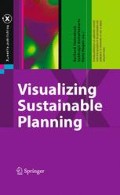Abstract
Due to complex, interwoven entities in the science of sustainability, an effective strategic approach that allows issues to be examined from various angles is needed to successfully integrate sustainability into public policy processes. Indicators can be an effective method for providing simple assessments of sustainability, however, there has been little research of indicator organization or visualization techniques to meet the unique information needs of public decision makers. There are numerous models for defining and organizing sustainability indicators but only a few provide defined methods of weighting and aggregation. There is also much published work on developing visualization methods and tools for decision making. However there is little research on how sustainable indicator visualization systems can be structured to meet the specific information needs of public decision makers as they address a wide range of issues at various spatial and functional scales. This article examines the current sustainability indicator and relevant visualization literature and proposes a theoretical organization and visualization framework for sustainability indicator data that blends data organization with flexible and simple information visualization.
Access this chapter
Tax calculation will be finalised at checkout
Purchases are for personal use only
References
Allard F, Cherqui F, Wurtz E, Mora L (2004) A methodology to assess the sustainability of rehabilitation projects in urban buildings. Retrieved 9/15/05, 2005, from http://www.costc16.org/downloads/ WORKING%20GROUP%203/AllardF%20Sustainable%20Rehabilitation%20.pdf
Baker MP, Bushell C (1995) After the storm: considerations for information visualization. IEEE Computer Graphics and Applications 15(3): 12–15
Bots PWG, Twist MJWV, Duin RV (1999) Designing a power tool for policy analysts: dynamic actor network analysis. (Paper presented at the 32nd Hawaii International Conference on System Sciences, Hawaii)
Brandes U, Kenis P, Wagner D (2003) Communicating centrality in policy network drawings. IEEE Transactions On Visualization And Computer Graphics 9(2): 241–253
Central Texas Sustainability Indicators Project (2004) Fifth annual report. Central Texas Sustainability Indicators Project, Austin Texas
Chen C (2004). Information visualization: beyond the horizon: Springer, Berlin, Heidelberg, New York
Clark WC (2003) Sustainability science: challenges for the new millennium. University of East Anglia, Norwich UK (An address at the official opening of the Zuckerman Institute for Connective Environmental Research, September 4, 2003)
Consultative Group on Sustainable Development Indicators (2006). The dashboard of sustainability. Retrieved 3/17/2006, 2006, from http://www.iisd.org/cgsdi/dashboard.asp
Crampton JW (2001) Maps as social constructions: power, communication and visualization. Progress in Human Geography 25(2): 235–252
DiBattista G, Eades P, Tamassia R, Tollis IG (1994) Algorythms for drawing graphs: an annotated bibliography. Computational Geometry Theory and Applications 4: 235–282
EUROCITIES (2004) Towards a strategy on the urban environment: Eurocities statement: European Union
Forester J (1989) Planning in the face of power. University of California Press, Berkeley California
Gallopín G (2004) Sustainable development: Epistemological challenges to science and technology. (Workshop on Sustainable Development: Epistemological Challenges to Science and Technology, ECLAC.) ECLAC, Santiago de Chile
Gudmundsson H (2003) Making concepts matter: Sustainable mobility and indicator systems in transport policy. International Social Science Journal 55(2): 199–217
Hallisey EJ (2005) Cartographic visualization: An assessment and epistemological review. The Professional Geographer 57(3): 350–364
Jern M, Franzén J (2006, July 2006) “Geoanalytics”: exploring spatio-temporal and multivariate data. (Paper presented at the Information Visualization 2006, London, United Kingdom)
Jolliet O, Friot D, Blanc I, Cenni F, Corbière-Nicollier T, Margni M (2003) Wp3 documentation, part 1: the sustainability model framework and indicators: The University of Minho, Portugal.
Klein G (1998) Sources of power: how people make decisions. The MIT Press, Cambridge Massachusetts
Lindblom CE (1995) Science of muddling through. In: McCool DC (ed.) Public policy theories, models, and concepts. Prentice Hall, Englewood Cliffs, New Jersey, pp. 142–157
Muller W, Schumann H (2003) Visualization methods for time-dependent data. (Paper presented at the 2003 Winter Simulation Conference)
Leake NL, Adamowicz WL, Boxall PC (2002) An examination of economic sustainability indicators in forest dependent communities in Canada: Sustainable Forest Management Network
Nardo M, Saisana M, Saltelli A, Tarantola S (2005) Tools for composite indicators building. European Commission, Directorate General, Joint Research Center, Ispra Italy
Nyerges T (2002) Visualizations in sustainability modeling: An approach using participatory GIS for decision support. Association of American Geographers, Los Angeles
Nyerges T L (2001, October 1–2, 2001) Research needs for participatory, geospatial decision support: linked representations for sustainability modeling. (Paper presented at the Intersections of Geospatial Information and Information Technology Workshop)
Prescott-Allen R (2001) The wellbeing of nations: a country-by-country index of quality of life and the environment. Island Press, Washington
Robertson GG, Mackinlay JD, Card SK (1991) Cone trees: animated 3d visualizations of hierarchical information. (Paper presented at the Conference on Human Factors in Computing Systems, New Orleans, Louisiana)
Shneiderman B (1992) Tree visualization with tree-maps: 2-d space-filling approach. ACM Transactions on Graphics 11(January): 92–99
SRP, S. R. P. (2004) Canada sustainability report: institute for Research and Innovation in Sustainability
Thomas J, Cook K (2005) Illuminating the path: the research and development agenda for visual analytics. Retrieved 11/1/2006, 2006, from http://nvac.pnl.gov/
Tufte ER (1990) Envisioning information. Graphics Press, Cheshire Connecticut
Tufte ER (1997) Visual explanations: Images and quantities, evidence and narrative. Graphics Press, Cheshire Connecticut
Venetoulis DJ, Chazan D, Gaudet C (2005) Ecological footprint of nations: Redefining Progress. www.redefiningprogress.org.
Wackernagel M, Onisto L, Linares AC, Falfán ISL, García JM, Guerrero AIS (1997) Ecological footprints of nations. Retrieved 9/15/05
Williams M (2004) Questvis and mdsteer: The visualization of high-dimensional environmental sustainability data. The University of British Columbia
Author information
Authors and Affiliations
Corresponding author
Editor information
Editors and Affiliations
Rights and permissions
Copyright information
© 2009 Springer-Verlag Berlin Heidelberg
About this chapter
Cite this chapter
Quay, R., Hutanuwatr, K. (2009). Visualization of Sustainability Indicators: A Conceptual Framework. In: Hagen, H., Guhathakurta, S., Steinebach, G. (eds) Visualizing Sustainable Planning. X.media.publishing. Springer, Berlin, Heidelberg. https://doi.org/10.1007/978-3-540-88203-9_13
Download citation
DOI: https://doi.org/10.1007/978-3-540-88203-9_13
Published:
Publisher Name: Springer, Berlin, Heidelberg
Print ISBN: 978-3-540-88202-2
Online ISBN: 978-3-540-88203-9
eBook Packages: Computer ScienceComputer Science (R0)

